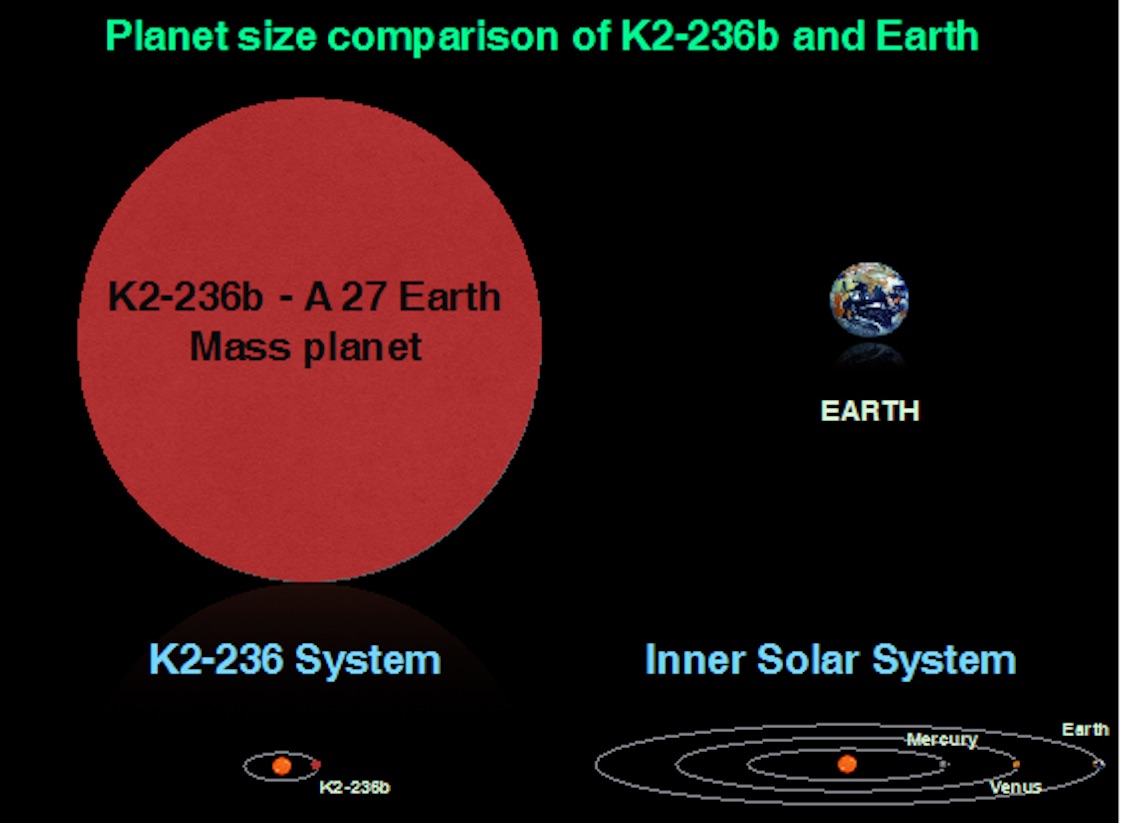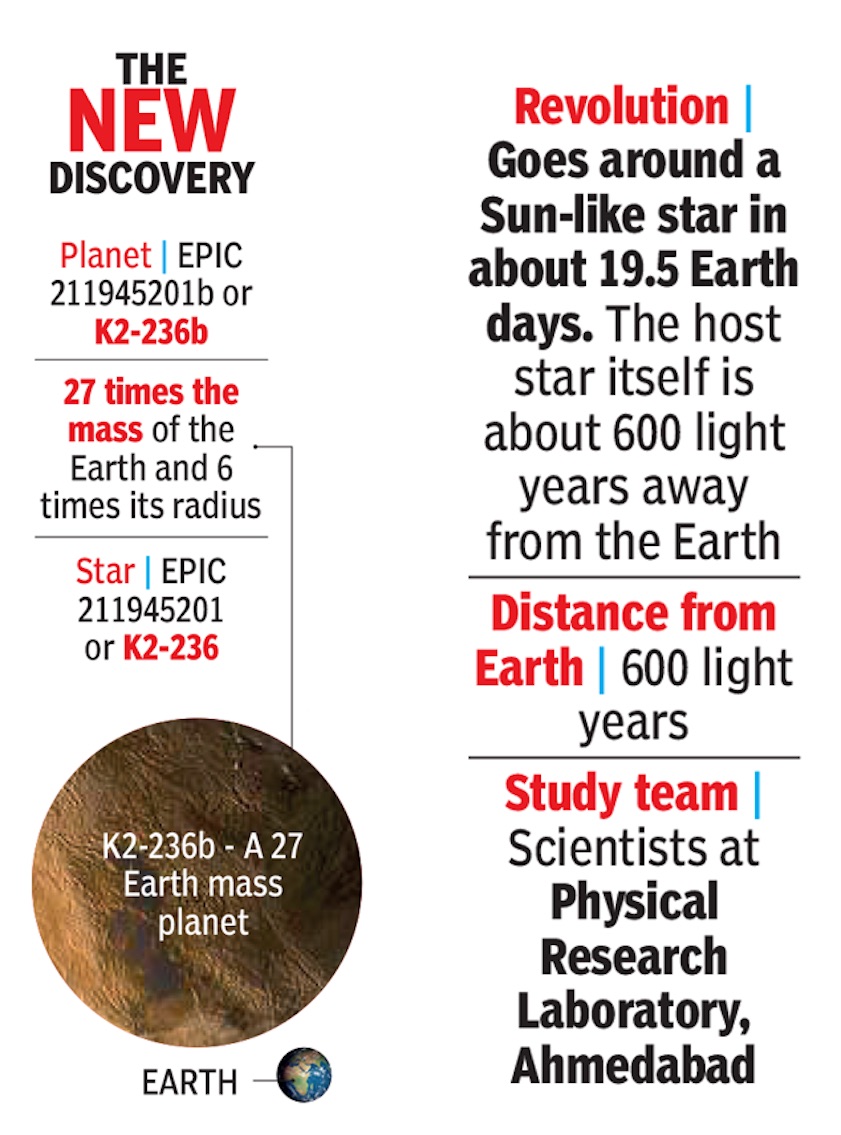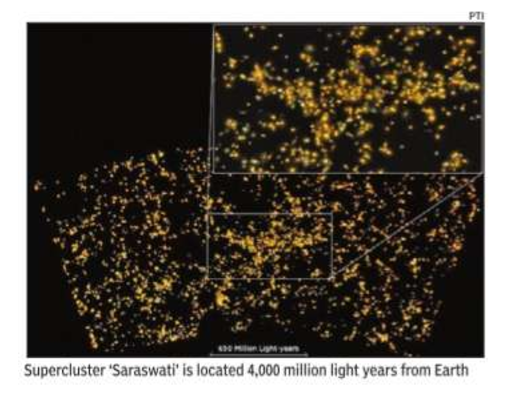Astronomy, Astrophysics: India
(→Gravitational waves) |
(→Shiva, Shakti: Milky Way’s earliest building blocks named thus in 2024) |
||
| Line 115: | Line 115: | ||
Mayuresh Surnis, assistant professor at the Indian Institute of Science Education and Research, said, “If you convert the GW to sound, the background detected could be called a hum. The background is made by superimposition of the GW caused by many sources . Once we analyse the data more, we will be able to say what kind of blackholes they were. We have detected the GW in low frequency and LIGO has done so in high frequency. So we are trying to find the entire spectrum of the GWaves.” |
Mayuresh Surnis, assistant professor at the Indian Institute of Science Education and Research, said, “If you convert the GW to sound, the background detected could be called a hum. The background is made by superimposition of the GW caused by many sources . Once we analyse the data more, we will be able to say what kind of blackholes they were. We have detected the GW in low frequency and LIGO has done so in high frequency. So we are trying to find the entire spectrum of the GWaves.” | ||
| − | |||
| − | |||
| − | |||
| − | |||
| − | |||
| − | |||
| − | |||
| − | |||
| − | |||
| − | |||
[[Category:Crime|BASTRONOMY, ASTROPHYSICS: INDIAASTRONOMY, ASTROPHYSICS: INDIAASTRONOMY, ASTROPHYSICS: INDIAASTRONOMY, ASTROPHYSICS: INDIA | [[Category:Crime|BASTRONOMY, ASTROPHYSICS: INDIAASTRONOMY, ASTROPHYSICS: INDIAASTRONOMY, ASTROPHYSICS: INDIAASTRONOMY, ASTROPHYSICS: INDIA | ||
Revision as of 22:04, 23 April 2024
This is a collection of articles archived for the excellence of their content. |
Contents[hide] |
Saraswati, supercluster of galaxies
2017, the discovery
Ardhra Nair|Desis find giant galaxy cluster|Jul 15 2017 : The Times of India (Delhi)
A team of Indian astrono mers claims to have dis covered an extremely large supercluster of galaxies -with a mass roughly equivalent to that of 20 million billion suns -which they have named `Saraswati'. “This is a very high concentration of galaxies in the universe and it is very rare.Few such structures have been observed till now and this is definitely a first from India,“ said the study's co-author Shishir Sankhyayan of IISER. According to the Pune-based Inter-University Centre for Astronomy and Astrophysics (IUCAA), superclusters are the largest coherent structures in the cosmic web. They are a chain of galaxies and galaxy clusters, bound by gravity, the IUCAA added. Saraswati is one of the largest known structures in the universe, 4,000 million light years from Earth and roughly over 10 billion years old, IUCAA said.
The supercluster was discovered by Sankhyanan; Joydeep Bagchi, a faculty member of IUCCA; Prakash Sarkar of the National Institute of Technology , Jamshedpur; Somak Raychaudhury , director, IUCAA; Joe Jacob of Newman College, Kerala; and Pratik Dabhade, IUCAA research fellow. Their findings were published in the latest issue of `The Astrophysical Journal'.
Sankhyayan said the supercluster extended over 600 million light years and may contain the mass equivalent of over 20 million billion suns.
Exoplanets discovered
2018: EPIC 211945201b/ K2-236b

From: U Tejonmayam, Indian scientists discover planet 600 light years away, June 8, 2018: The Times of India
HIGHLIGHTS
The discovery was made by measuring the mass of the planet using the PARAS spectrograph integrated with 1.2m telescope in Mount Abu.
With this discovery, India has joined a select league of countries which has discovered planets around stars.
A team of scientists from the Physical Research Laboratory (PRL), Ahmedabad, discovered a sub-Saturn or super-Neptune size exoplanet, which is about 27 times the mass of Earth and six times the radius of Earth. The planet revolves around a Sun-like star, some 600 light years away from Earth.
The discovery was made by measuring the mass of the planet using the indigenously designed ‘PRL Advance Radial-velocity Abu-Sky Search’ (PARAS) spectrograph integrated with 1.2m telescope at PRL’s Gurushikar Observatory in Mount Abu. With this discovery, India has joined a select league of countries which has discovered planets around stars.
In a post on the website of the Indian Space Research Organisation, scientists said the name of the host star is EPIC 211945201 or K2-236 and the planet will be known as EPIC 211945201b or K2-236b. The planet was found to go around the star in about 19.5 days.
The surface temperature of the planet was found to be around 600 degrees Celsius, as it is very close to the host star. It is seven times nearer to its star, in comparison with Earth-Sun distance. This might make it uninhabitable The discovery is of importance for understanding the formation mechanism of such super-Neptune or sub-Saturn kind of planets, that are too close to the host star, according to scientists.
Paras spectrograph made an independent measurement of the mass of the planet body, as it was necessary for discovery after data from Nasa’s K2 (Kepler2) photometry could not confirm the planetary nature of the system. Initially, it was Nasa’s K2 (Kepler2) photometry that found that the source was a planetary candidate as it was transiting, where the planet body comes between the star and the observer on Earth.
It goes around the star and therefore blocks a tiny amount of star-light. By measuring the amount of light blocked by the planet body, the diameter or size of the planet can be measured. It was found to be 6 Earth radii. However, that data was not sufficient to confirm the planetary nature of the system.
PRL scientists, who observed the target for about 1.5 years with the spectrograph to probe the nature of the system, made calculations that suggested that the heavy elements like ice, silicates and iron content make 60%-70% of the total mass.
This detection was important as it adds to a sparse catalogue of confirmed exoplanets with masses between 10 and 70 MEarth and radii between 4 and 8 REarth, whose masses and radii are measured to a precision of 50% or better.
Only 23 such systems (including the present) are known to this date with such precise measurement of mass and radii.
Exoplanet find that put India in select league
U Tejonmayam, June 12, 2018: The Times of India

From: U Tejonmayam, June 12, 2018: The Times of India

From: U Tejonmayam, June 12, 2018: The Times of India
HIGHLIGHTS
Scientists at Physical Research Laboratory (PRL), Ahmedabad, have discovered a new planet.
Scientists said the name of the host star is EPIC 211945201 or K2-236.
The planet will be known as EPIC 211945201b or K2-236b.
In the universe of never-ending stars, planets and galaxies, India has made a place for itself by discovering a sub-Saturn or super-Neptune sized planet, which is about 27 times the mass of Earth and measures six times its radius. With this discovery, the country has joined a select league of countries, which has discovered planets around stars.
A team of scientists at Physical Research Laboratory (PRL), Ahmedabad, discovered the planet, which revolves around a sun-like star some 600 light years away, by measuring the mass of the planet using the indigenously designed PRL Advance Radial-velocity Abu-Sky Search (Paras) spectrograph integrated with a 1.2m telescope at PRL’s Gurushikar Observatory in Mount Abu.
After watching the planet for more than a year, the team led by professor Abhijit Chakraborty came up with the deductions, the details of which will appear in the June issue of the Astronomical Journal of the American Astronomical Society.
In a post on the Indian Space Research Organisation’s website, scientists said the name of the host star is EPIC 211945201 or K2-236 and the planet will be known as EPIC 211945201b or K2-236b. With a surface temperature of 600°C, the planet was found take 19.5 Earth days to go around the star. Being seven times nearer its star in comparison with the Earth-Sun distance, it is uninhabitable.
According to scientists, the discovery is of importance for understanding the formation of such super-Neptune or sub-Saturn planets that are too close to the host star.
Initially, it was Nasa’s K2 (Kepler2) photometry that found that the source was a planetary candidate as it was transiting, where the planet body comes in between the star and the observer on Earth. Transiting is the process when the planet goes around the star and blocks a tiny amount of star-light. By measuring the amount of light blocked by the planet, its diameter or size can be measured. In this case Nasa data was not sufficient to confirm the planetary nature of the system.
Paras spectrograph, an instrument that separates light into a frequency spectrum and records the signal using a camera, made an independent measurement of the mass of the planet. PRL scientists observed the target for about 18 months and made calculations that suggested that elements like ice, silicates and iron content make 60% to 70% of the total mass. This detection was important as it adds to a sparse catalogue of confirmed exoplanets.
2021
Nov 18, 2021: The Times of India
Scientists at the Ahmedabadbased Physical Research Laboratory (PRL), under the Department of Space, have discovered a new exoplanet orbiting too close to an evolved or aging star with a mass of 1.5 times that of the Sun and located 725 light years away. The exoplanet’s mass is found to be 70% and size about 1.4 times that of Jupiter.
The discovery was made using PRL’s advanced radial-velocity abu-sky search (PARAS) optical fiber-fed spectrograph, the first of its kind in India, on the 1.2-metre telescope situated at Mount Abu observatory. The discovery team includes Prof Abhijit Chakraborty, students and his team members, and international collaborators from Europe and the US, an Isro statement stated.
This is the second exoplanet discovered by PRL scientists using PARAS. TNN
Gravitational waves
2023: low-pitch “hum”
Surendra Singh, Ardhra Nair & Swati Shinde Gole TNN, June 30, 2023: The Times of India
In a major breakthrough, a global team of astronomers that included scientists from seven Indian institutes have, for the first time, heard the low-pitch “hum” of gravitational waves reverberating across the universe, the existence of which was predicted by Albert Einstein.
India’s upgraded Giant Metrewave Radio Telescope (uGMRT) near Pune was one of the world’s six most sensitive radio telescopes that played a key role in discovering the persistent hum. The gravitational waves (GW) are thought to have originated from the merger of supermassive black holes in the early universe, soon after the Big Bang. With this discovery, scientists hope to learn more about physical reality and answer mysteries about the nature of merging supermassive black holes and what brings them together.
InPTA experiment involved 7 Indian institutes’ researchers
The findings, reported in a series of papers in The Astrophysical Journal Letters on Thursday, come from 15 years of observations made by North American Nanohertz Observatory fo r Gravitational Waves (NANOGrav) with more than 190 scientists, including from Indian Pulsar Timing Array (InPTA) that used uGMRT. The Indian telescope was used to collect and correct the signal an d increase the accuracy of the signal so that it could corroborate the “hum” of the universe, as detected by their European counterparts.
The first experiment of the pulsar timing array started in 2002 and I nPTA got involved in 2016. The InPTA experiment involves researchers from NCRA (Pune), TIFR (Mumbai), IIT (Roorkee), IISER (Bhopal), IIT (Hyderabad), IMSc (Chennai) and RRI (Bengaluru) along with the ir colleagues from Kumamoto University, Japan.
Gravitational waves were first proposed by Einstein in 1916 but were not directly detected until about 100 years later when the National Science Foundationfunded LIGO in 2016 picked up the waves from a pair of distant colliding black holes. However, LIGO detected gravitational waves that were much higher in frequency th an those registered by NANOGrav.
Mayuresh Surnis, assistant professor at the Indian Institute of Science Education and Research, said, “If you convert the GW to sound, the background detected could be called a hum. The background is made by superimposition of the GW caused by many sources . Once we analyse the data more, we will be able to say what kind of blackholes they were. We have detected the GW in low frequency and LIGO has done so in high frequency. So we are trying to find the entire spectrum of the GWaves.”
See also
Astronomy, Astrophysics: India
